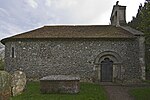Andwell
AC with 0 elementsHampshire geography stubsVillages in Hampshire

Andwell is a village in the Basingstoke and Deane district of Hampshire, England. Its former range was divided by the M3 motorway; it is also bounded to the north by the A30 road. Winchester College has owned land in the village since the 1390s.
Excerpt from the Wikipedia article Andwell (License: CC BY-SA 3.0, Authors, Images).Andwell
M3, Basingstoke and Deane Newnham
Geographical coordinates (GPS) Address Nearby Places Show on map
Geographical coordinates (GPS)
| Latitude | Longitude |
|---|---|
| N 51.268 ° | E -1.0136 ° |
Address
M3
RG24 7NG Basingstoke and Deane, Newnham
England, United Kingdom
Open on Google Maps










